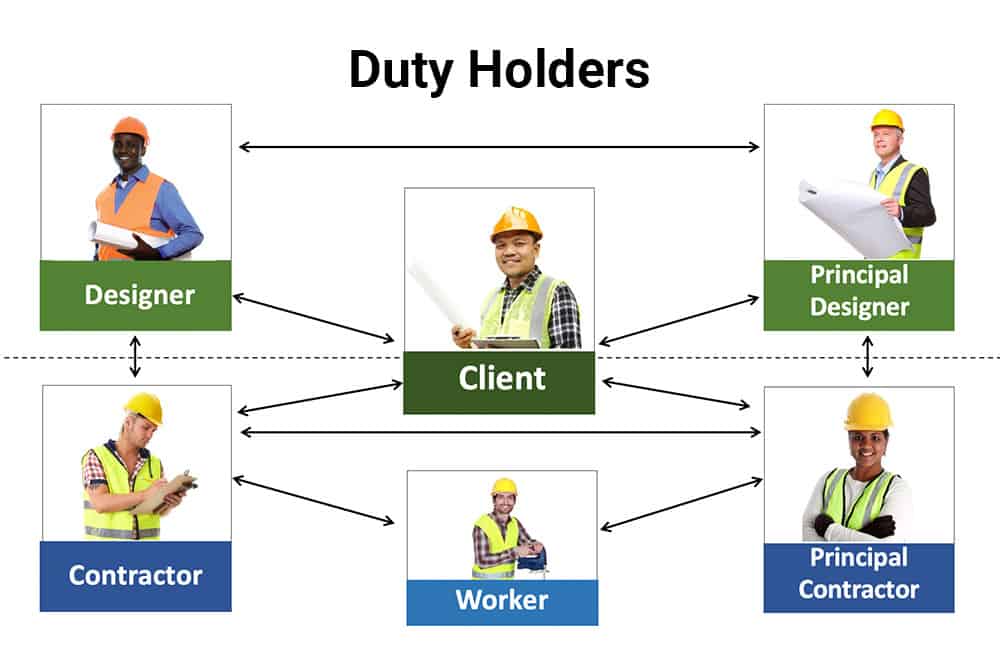
Under the Construction Design and Management (CDM) Regulations 2015, every person involved in a construction project has a specific role to play. The CDM Regulations 2015 provides clear definitions for the people performing these roles, the so-called duty holders. Each duty holder has specific duties and responsibilities.
In this blog post, we will take a closer look at the roles of duty holders under the CDM Regulations 2015 in more detail.
What are Duty Holders?
A CDM project is a team approach and sitting at the centre with overall control is the Client.
In order to effectively draw up designs and plans, Clients are assisted by the roles of the CDM Principal Designer and the Designer.
Eventually, someone has to actually carry out the work, so the client must appoint a Principal Contractor who in turn will appoint Contractors and, of course, Workers.

As we will see, there is a need for close communication between these CDM roles throughout the duration of the project. Each duty holder must work with the others as a cohesive team.
Let’s take a closer look at each of these roles in turn.
Clients
Clients are organisations or individuals for whom construction projects are carried out. Examples of commercial clients are:
- Schools
- Retailers
- Landlords
On a domestic construction project, the Client is the homeowner.
Clients are the head of the procurement chain. This means that the client has the overall responsibility for ensuring the safety of the project. This responsibility includes dictating the standards and culture under which the build will operate.
Principal Contractors
The Principal Contractor is the contractor in overall control of the construction phase. There should only be one Principal Contractor for a project at any one time. On projects where there is more than one contractor, the Principal Contractor will be appointed by the client in writing.
The Principal Contractor is responsible for managing all Contractors and their Workers. So, for example, a roofing contractor would be the Principal Contractor on a domestic project if they employed other contractors, such as a contractor to provide scaffolding.
Principal Designers
Principal Designers are designers appointed by the client. On projects with more than one contractor, designers can be an organisation or an individual. They must have sufficient knowledge, experience, and the ability to carry out the role.
The CDM Principal Designer has the overall responsibility for the design of a construction project, including ensuring that:
- The building work can be undertaken safely, and
- That the final structure is safe to use
The primary aim of this role in the CDM team is to either eliminate or reduce risk through effective building design.
Designers
Designers prepare or modify designs for a building, product or system relating to construction work. This can include, for example, a structural engineer appointed by a Principal Designer as a CDM advisor to advise on the strength requirements of a building.
However, a Designer could also be an electrician who adjusts a wiring design to accommodate required changes during the construction phase.
It does not matter if the design is recorded or not, for example, on paper or a computer.
If a design change is made and only communicated orally, then the person involved becomes a Designer under the CDM Regulations 2015. Many people unwittingly take on this duty holder role without realising it.
Contractors
Contractors are those people who do the actual construction work. In other words, they plan, manage and monitor all construction work under their control.
Contractors can be either an individual, sole trader or a company. Anyone who directly engages construction workers or manages construction work is a Contractor according to the CDM Regulations 2015. This includes companies that use their own workforce to do construction work on their own premises.
The duties and responsibilities of Contractors apply if their workers are:
- Employees
- Self-employed
- Agency workers
Workers
Workers are the people who carry out the work on a construction site under the control of Contractors.
Workers must be consulted on matters which affect their:
- Health
- Safety
- Welfare
The Competency of Duty Holders
The CDM Regulations 2015 require that all duty holders must have the necessary knowledge, skills and experience to do the job safely. This includes the ability to ensure they don’t put themselves or anybody else at risk.
The Overall Responsibility of the Client
The Client has the overall responsibility for ensuring this competency requirement is fulfilled throughout the CDM team. Often, Clients delegate this task to the Principal Designer and the Principal Contractor. However, they must still check and ascertain if these duty holders are carrying out their instructions effectively.
The Pre-Construction Phase
It is the requirement of anyone appointing a Designer or Contractor to ensure their competence. Often, this duty falls to Principal Designers and Principal Contractors.
The Construction Phase
During the construction phase, the Principal Contractor must check that all Contractors and their Workers have had the training they need to work safely if this duty falls to them.
In addition, during the construction phase, the Principal Contractor must ensure that all Contractors and Workers:
- Are supervised
- Are given clear instructions
- Have the right tools, equipment, plant, materials and personal protective equipment or PPE
- Are consulted about health and safety issues, and
- Have health surveillance arrangements in place for Workers, where required
Further Information and Training on the CDM Regulations 2015
Every person who is involved in a building project has a role as a duty holder under the CDM Regulations 2015. Ensuring that your construction team has a clear understanding of all CDM roles and responsibilities will ensure that the worksite is safe and complies with relevant legislation.
One way to provide your team with the training they need is to have them take an online health and safety course. As a leading provider of workplace e-learning, Human Focus offers a wide range of online courses covering a variety of health and safety issues.
The Human Focus CDM Duty Holder Training course provides detailed information covering all CDM roles, the principles of CDM and the legal responsibilities of CDM duty holders. This course can be taken online and is assured by the Royal Society for the Prevention of Accidents (RoSPA).



















































































































































































































































































































































































































































































































































































































































































































































